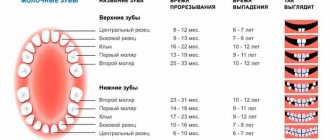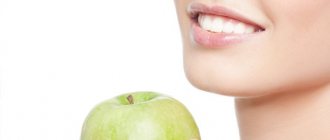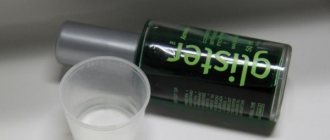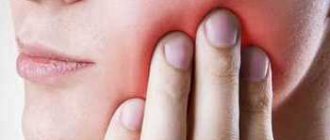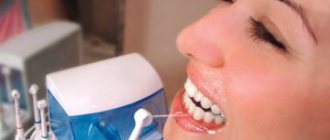How to pull out a baby tooth with floss
The essence of the method is that a loose tooth is tied with a thread, the other end of which is tied to the door handle.
The door opens and the tooth flies out of the mouth. This technique does not withstand any criticism either from dentists or from psychologists. A morally outdated method that can frighten a child and even cause psychological trauma.
Home manipulations often lead to infection in the socket. Inflammation may develop - flux, pain and fever will appear. The best solution is to have loose baby teeth removed at a dental clinic. It's fast, painless and inexpensive.
Nature has provided for everything
Losing baby teeth is a natural and inevitable process that everyone goes through in childhood. Most often it begins at 5-6 years of age and passes painlessly. Sometimes the replacement of temporary teeth may begin earlier or, conversely, late. Some deviations from the usual indicators are not always considered a violation, since much depends on the health and physiological state of the child. When he begins to change his teeth, we recommend making an appointment with the dentist, as this is a very important period for the formation of your baby’s bite.
Reasons for late eruption
Normally, after a baby tooth falls out, it takes 1-2 months for the permanent tooth to erupt. This is the longest period. In most cases, the rudiments of a permanent tooth can already be seen at the site of the lost tooth.
But, if a child’s toothless smile persists for 3 months or more, then this is a cause for concern for parents.
Let's consider why such dental pathology occurs:
- Retention
– a common condition that mainly affects the incisors and canines. They cannot erupt due to dense gums or because they rest against neighboring teeth. There are complete and partial retention. With the full form, a healthy root is visible in the picture, but it is completely under the gum. With partial retention, only part of the crown is visible. In this case, surgical assistance is required.
- Edentia
– a congenital pathology in which there is a lack of rudiments of permanent dental units. Can be complete or partial (sparse teeth). A rare disease. Orthopedic treatment is required as early as possible.
- Impact
– delayed eruption in this pathology is associated with a mechanical obstacle, that is, the child has a supernumerary of dental units. In this case, the permanent root simply does not have room to erupt. Impaction can only be detected using a panoramic x-ray of the jaw.
The sooner the child is examined by a doctor, the higher the chance of having an even and complete dentition.
What you should pay attention to
The child’s body prepares in advance for the period of teeth change. Here are the main signs of the changes taking place:
- mobility and loosening of primary teeth
- redness and swelling of the gums
- the appearance of interdental spaces due to jaw growth
- the rudiments of a permanent tooth become visible
When a baby tooth is replaced with a permanent one, the root gradually dissolves. The process is helped by a new tooth pushing out the temporary one from below.
Usually children and their parents remove the loose tooth themselves. But we recommend contacting a specialist who will provide professional assistance.
Useful tips for parents
- Monitor your baby's teeth closely. If there are several children in a family, it is better for each of them to have a sign indicating the lost and emerging teeth.
- Teach your child to take care of their teeth. Teach him to brush his teeth twice a day and rinse his mouth after eating. You can use plain water or herbal decoction of chamomile.
- During the teething period, give your child plenty of calcium. Avoid solid foods and feed your baby soft purees, grated fruits and other foods.
- Discuss the upcoming change of teeth with your child so that it does not come as a surprise to him.
If you observe difficulties with the germination of dental units, this is a reason to immediately consult a dentist. Remember that changing teeth is a stressful process for your child. Support him so that this period passes with minimal psychological losses.
In what order do teeth fall out?
The loss of baby teeth occurs in the same order in which they first erupted. First, the child loses the lower and upper incisors, then the lateral molars, and lastly the canines. The replacement of baby teeth with permanent teeth begins at the age of 5.5 years and ends at the age of 13. At the same time, instead of 20 dairy ones, 28 permanent ones grow. There is room for eight new chewing teeth due to the expansion of the jaws. By the way, wisdom teeth most often erupt in adulthood, and for some they do not grow at all.
Features of baby teeth
Now I will answer another very popular question: “how do baby teeth differ from molars?”
These are the baby's very first teeth. They appear before the age of three, and begin to erupt until there are 20 teeth. See the photo above for the cutting diagram.
They do not have such deep roots as permanent teeth, have a more rounded shape and smaller size, and are white in color, while permanent teeth have a yellowish tint. By location, they are directed vertically, and the radicals are slightly outward.
Wisdom teeth cannot be milk teeth, because they grow into deep roots only by the age of 18-20, and sometimes later.
What to do if a tooth does not fall out in time
According to statistics, in 20-30% of cases, children experience a “shark smile” when the permanent tooth has already erupted and is growing, but the milk tooth has not yet fallen out. Clinical studies have proven that in such a situation, parents should not hesitate to go to pediatric dentistry. The doctor will carefully examine your child's mouth and remove the temporary tooth. If you do not contact the dentist in a timely manner, double dentition can lead to improper formation of the bite, impaired diction and the functioning of the digestive system. In addition, with a “shark smile” it is difficult for a baby to bite and chew food, particles of which remain between the teeth and under the gum. As a result, inflammatory processes and caries occur. All this can be avoided by making an appointment with a specialist.
Daily doctor's advice on caring for baby teeth:
- Start brushing your baby's teeth only after they have erupted; use a special brush for babies.
- When your child turns one year old, buy a brush with soft bristles and toothpaste without fluoride; it will not harm the child if he swallows it.
- Brush your baby's teeth 2 times a day (morning and evening)
- Don't put off going to the dentist. They should be regular, even if there are no signs of concern.
- Include more fresh greens, fruits and vegetables in your diet.
Orthodontic treatment – caring for the future
Some parents do not attach importance to the fact that the baby tooth has not yet fallen out, but the permanent one is already emerging. Or, on the contrary, the temporary one is lost early, and the tooth that replaces it does not grow. If you notice deviations, we recommend that you contact an orthodontist as soon as possible, who will provide effective treatment.
For example, with the premature loss of a baby tooth, the free space is very quickly taken up by neighboring teeth. There is not enough space for a permanent one. Therefore, it is very important when forming a temporary occlusion to fill such gaps, preventing the occurrence of an occlusion anomaly. To hold space for a permanent tooth, orthodontics uses a plate with artificial teeth. For single defects, a non-removable “ring-loop” design is most often used. The device does not cause discomfort, and the child wears it until the permanent tooth erupts.
The product manufacturing process is standard: impressions are taken, models are made, and the design is created in the laboratory within two weeks. Its fixation takes 15-20 minutes. After installing the device, you do not need to drink or eat for 2 hours. It is better to limit the consumption of “pulling” foods - toffees, chewing gum, etc.
How to behave if your child’s first tooth falls out?
The first baby tooth that falls out is another step towards growing up. So why not mark this event with some interesting ritual for the child, so that further loss will be easier for the baby and bring more joy.
Tooth Fairy
Give your baby a little magic. Let the good sorceress take the first tooth from under the pillow while he sleeps, and in return leave a small gift: candy, a coin or a toy. The next baby tooth that falls out will bring joy to the baby.
Mouse
Another tradition that children really like is to give a lost tooth to a mouse. The mouse will chew the old tooth, and a new one will appear in its place.
Together with your baby, you need to find a secluded corner in the house and put the fallen tooth there. At night, a mouse will run into the corner and take it away.
We hope that falling out baby teeth and emerging permanent teeth will not cause trouble for either children or parents. And to make the first molars give the baby even more joy, we have developed a special Asepta Teens toothpaste to protect and strengthen the enamel of permanent teeth in children over 8 years old. The paste increases the resistance of enamel to bacteria and acids, helps saturate teeth with calcium and phosphorus, and provides effective protection against caries and gum inflammation. And the rich taste of apricot, peach and cream will turn brushing your teeth into a real treat.
Doctors are our pride
We did the research and found out why they trust us. In reviews
On our website, parents note the highly qualified doctors who have knowledge of several related areas and have extensive experience
working with children
. This allows you to see the clinical picture as a whole and plan treatment correctly.
In 2022, family dentistry "DOMOSTOM" in Domodedovo entered the TOP 100 private children's dental clinics in Russia according to the rating of the expert magazine about dentistry Startsmile with the support of Kommersant Publishing House.
Our clinic’s team of professionals knows how to help your child. Sign up for a consultation with us. Attentive doctors will tell you in detail about the condition of the baby’s oral cavity and answer all questions.
Why is the order of changing teeth important?
First, the incisors, and only then the molars and canines - this order determines the normal course of jaw development and the formation of a correct bite. If teeth fall out in the wrong order, this can lead to malocclusion and subsequent problems.
Malocclusion is not only an aesthetic problem that changes facial features, but a physiological one. As a result, pronunciation and clarity of speech are impaired, the quality of chewing food deteriorates, which can lead to disruptions in the functioning of the gastrointestinal tract.
Several reasons can cause a disorder in the order of tooth loss:
- trauma - the baby hit himself and knocked out or damaged a tooth, causing it to fall out prematurely;
- diseases of the oral cavity - enamel hypoplasia, caries or pulpitis.
It happens that parents “neglect” the condition of the child’s oral cavity, believing that there is no need to care for or treat baby teeth. They'll fall out soon anyway. This leads to negative consequences.
Firstly, the baby does not develop a culture of oral care. And at an older age, he will not closely monitor the health of his molars, which will cause the active development of carious processes and their early loss.
Secondly, caries of baby teeth is not a harmless disease. It destroys teeth, causing them to fall out earlier, spreads aggressively in the mouth and can infect the molars and molars, which are located in the gums. Caries in children must be treated. And the sooner parents notice white or dark spots on the enamel and the sooner they consult a doctor, the greater the chance that the doctor will “catch” the disease at an early stage. And it will not have time to lead to dangerous consequences for the baby’s health.
If the order of changing teeth is disrupted as a result of injury or illness, you should consult a doctor. It is important to consult a pediatric dentist to help get rid of oral diseases. And also an orthodontist, who will recommend options for correcting the primary bite and select means that do not allow the teeth located next to the freed space to move arbitrarily.
pixabay.com/
Why do empty spaces remain unoccupied for a long time?
It often happens that a child walks around with a toothless smile for a long time, but the situation still does not change. When examining his oral cavity, the parents do not see even a hint of an imminent full bite. This happens when:
- Retentions. Dental pathology in which a segment of gum tissue is shown very little or not at all. The violation may be complete or partial. In any case, if it occurs, you should consult your dentist. Sometimes the situation can only be corrected through surgery.
- Edentia. The banal absence of a permanent germ. So, for example, a temporary fang falls out, and there is nothing to replace it with. The anomaly can be confirmed using x-ray diagnostics - the images show that the rudiment is missing. Fortunately, congenital adentia is rarely diagnosed in young patients. If it is, only prosthetics will save you.
- Impacts. Difficulties with eruption with this diagnosis are explained by the fact that the crowns of the “neighbors” are too close to each other and do not leave room for the crown, which should be between them. Deviations can also be detected using x-rays.
If there are any problems with the bite, parents should show the baby to the doctor. Moreover, children should have annual checkups at the dentist's office. This simple measure serves as an excellent prevention of serious complications and reduces the likelihood of an unattractive smile in adulthood.
Is it possible for children to lose molars?
In childhood, molars are just emerging, so, of course, they cannot fall out in a healthy baby. Sometimes parents confuse large molars located deep in the jaw with permanent teeth. And they get scared when a child brings such a large tooth in his palm.
You can lose your permanent dentition as a result of an inflammatory process in the oral cavity - periodontitis. Or against the background of scurvy, a rare disease in modern society associated with a chronic lack of vitamin C in the diet.
But despite this, if you have any doubts, you should consult a doctor. After all, bite formation is a responsible process. And if it is carried out under the supervision of a specialist, there is a much greater chance that the teeth will grow healthy, even and beautiful. To do this, you need to undergo regular dental examinations. And if the dentist recommends consulting an orthodontist, you should not refuse this recommendation.
In dentistry, the following types are distinguished:
- Bruised tooth. It can be considered the mildest type of injury, which is provoked by blows, attempts to bite through a hard object or “taste” it, which is especially typical for children 1-3 years old.
- Tooth dislocation. Such an injury means that the tooth has moved from its usual place. Typically, this type of injury requires significant force, so it does not occur as often as bruises. There are cases of complete dislocation, when the entire tooth falls out of the socket. Modern pediatric dentistry can save even a lost tooth if there are favorable conditions for this, and parents brought their child in immediately after receiving an injury.
- Tooth fracture. Fractures are immediately visible - these are visible chippings of a corner, piece or most of a baby tooth. Most children break their front teeth; the most popular causes of such damage include fights.
- Fracture of the root or crown of a tooth. They are considered rarer species, because in normal everyday life and sports conditions it is extremely difficult to get such a deep fracture. Regardless of whether the child has acquired a simple tooth bruise or suffered a fracture, in any case it must be shown to a specialist so as not to endanger the health of the young body.
At what age do radical units appear?
We can talk about adult occlusion only a few years after the start of the change in time units. Typically, a stronger replacement will erupt several weeks or months (or, if pulled out prematurely, years) after the baby teeth fall out.
Central incisors grow from 6 to 8 years of age, lateral incisors from 7 to 9, premolars and canines from 9 to 12. Molars begin to grow at approximately six years of age. They immediately grow permanently, replacing the empty space.
What to do when teething?
The first teeth erupting will cause discomfort in the child, and this is a natural process. During this period, salivation increases, and a runny nose may occur due to the eruption of the upper teeth. The normal pace is for new teeth to appear every few weeks.
Be prepared for the fact that the child will be capricious and refuse to eat, and his temperature may rise. To make this period easier, you can use special teething toys. During this period, the gums become inflamed and cause discomfort - they can itch and hurt. Talk to your dentist: There are safe cooling gels for children that can help reduce the intensity of teething and teething symptoms in children.
It is also recommended to replace drinks with plain water. Juices and other drinks that contain sugar create an acidic environment in the mouth. Because of this, an inflammatory process may begin. Care should be taken to disinfect pacifiers and toys that children may put in their mouths.
The first teeth appear at the age of six months. The first chewing teeth appear between the ages of 1 and 1.5 years. Fangs are cut between the ages of 2 and 2. After this, by the age of 3, the following chewing teeth appear. Each new group requires attention. Thus, it is important to brush your chewing teeth well after eating, since the enamel of baby teeth is quite weak. Retention of food on the surface can easily cause inflammation.
It is also important to ensure that the child weans the habit of the pacifier and stops putting his fingers in his mouth. If this does not happen, an incorrect bite will be formed.
What to do after a child’s tooth extraction?
- Make sure that the child spits out the tampon that was placed after removal after 15-20 minutes.
- After removal, a blood clot should remain in the hole, which protects it from inflammation. There is no need to clean the hole from blood, rinse the mouth, the child should not touch the removal site with hands or objects.
- If the child has been given anesthesia, explain to the child that he should not bite on the numb side until the feeling of cold and pins and needles goes away.
- Feed your baby only warm, soft food for several days.
- Maintain good hygiene; brushing your teeth is not only possible, but also necessary, with a soft toothbrush, carefully avoiding the extraction site.
- If the tooth extraction was difficult, then try to limit the child’s physical activity so as not to provoke bleeding.
